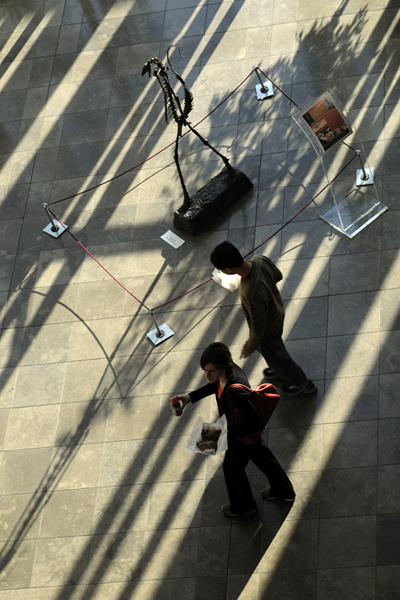Art in science
By Amy Braverman Puma
Photography by Dan Dry

Visitors to the Gordon Center's Art in Science exhibit walk past Paul Sereno's Giacomettisaurus sculpture.
Just off the elevators on the Gordon Center’s third floor, Michael LaBarbera’s Bay Scallop—Looking Back jumped out at visitors, displayed among other photographic prints. The image’s neutral background—dirty white waves and jelly-like bristles—set off eight of the organism’s turquoise eyes, seven marching along a diagonal and a lone outlier at the upper right.
Hundreds more eyes were outside the photo’s frame. So what would an organism with virtually no brain do with so many eyes? “We know that the scallop can use its eyes to census the number of particles in the water, which it eats,” LaBarbera says, “and it has been claimed that they can see predators like crabs approaching, but the evidence is pretty bad for the latter.” The two-inch diameter scallop—Argopecten irradians—was found in the northern Gulf of Mexico, and LaBarbera used the live specimen while teaching Invertebrate Zoology last spring quarter.
With the other 40 or so pieces in the Science in Art exhibit, which brightened the Gordon Center’s atrium October 10 through December 13, the photo was one example of science’s beauty. The exhibit, in its second year, was designed to show how “people incorporate art into science or science into art,” says organizer Rebecca Ayers, a PhD student in biochemistry and molecular biology who also paints.
Some pieces, like LaBarbera’s, came from scientists at the University, Argonne National Lab, or Fermilab, but others were by local artists who explore scientific themes, theory, or imagery. Chicago artist Vesna Jovanovic, for example, contributed Timekeeper, a self-portrait in which she overlaid several years’ worth of full-body X-rays, then drew or painted clock gears over the heart and other organs. Near the arms she sketched the beginnings of wings, showing what may come in thousands of years. “The piece is a record of the passing of time,” she noted in her artist’s statement, “not only a lifetime (illustrated by the medical scans), but also time through evolution, technology, and culture.”
Another local artist, Jesse Seay, exhibited Mechanical Tide, a kinetic sculpture on which metal ball bearings ran across grooves she carved into an 8 by 5–foot wooden board. As a motor slowly tilted the platform back and forth, the balls rolled randomly, like waves hitting sand. While the sculpture was up, Ayers says, physics professors gathered to watch the beads in motion and “discuss why the distributions were random.”
Some of the works emphasized the beauty of data sets, pieces a casual viewer may appreciate but a scientist can treasure because they capture moments, Ayers says, when a researcher realizes that a graph reveals something new. “Often after that moment you’re shuttled into the next stage and keep gathering data, and that initial euphoric sense gets diluted.”
Exhibit artist Josh Kurutz, a former postdoc in biophysicist Ka Yee Lee’s lab who’s now technical director of the University’s nuclear-magnetic resonance (NMR) facility, plays with data sets both visually and aurally. In Epinephrine, he pressed dried flowers in the pattern that an epinephrine molecule’s spectrum charted on the NMR machine. In Sex and Synesthesia, he displayed the visual charts of testosterone and estrogen and also hung iPod headphones through which listeners could hear the hormones’ audio waves. The waves, made from broadcasting radio-frequency energy at the substances, sounded like the plucking of low-tone guitar strings.
Two faculty members contributed their takes on iconic art. Paleontologist Paul Sereno’s 2004 metal-frame sculpture Giacomettisaurus imitated Albert Giacometti’s long, lean human shapes to create a dinosaur. And biochemist Keith Moffat’s 1968 Perspex and nylon sculpture Linear Construction Number 1 was “based on direct measurement” of constructivist Naum Gabo’s original of a similar name, Moffat wrote in his statement. Moffat saw Gabo’s series of white nylon threads pulled taut and arranged to create curving shapes at London’s Tate Gallery in 1967 and thought, “I can do that!” Gabo learned of the copy and, Moffat says, “was furious.”
Indignation aside, Moffat’s reproduction of Gabo’s study in geometry exemplified one of the goals of the exhibit: to “look more deeply,” Ayers says, “at the intersection between science and art.”
Return to top